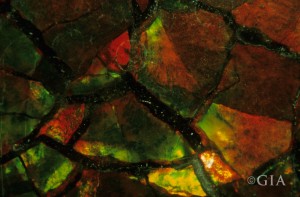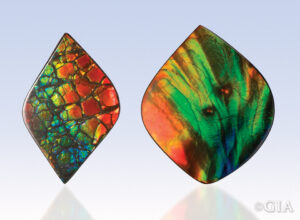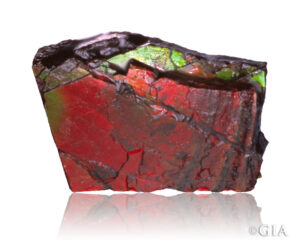If you’re intrigued by the origin of gemstones, then you’re probably going to love ammolite. Ammolite is iridescent fossilized ammonite shells found in Southern Alberta, Canada.
Ammonites were marine creatures similar to squids, but with coiled shells divided internally into chambers. They came into existence when the Earth had only one continent (Pangea) with no forests or mammals. Schools of ammonites hunted in the global ocean called Panthalassa. These predators with sharp, beak-like jaws buried in a ring of tentacles ate what they could catch.
Ammonites survived until the end of the Cretaceous period when a mass extinction occurred about 66 million years ago. They suffered the same fate as the dinosaurs as their demise was likely caused by an asteroid striking the earth and the cooling of the climate.
Most ammolite is green and red. Blue and violet ammolite is more rare, and typically more expensive. Generally, the more colors a piece has, the more valuable it may be. Finding an intact fossil that escaped the crushing weight of thousands of feet of sediment and the ravages of millions of years is quite rare, and therefore, quite valuable.
Ammolite is described as either fractured or sheet. Fractured ammolite resembles stained glass; sheet ammolite is an unbroken piece where the colors are continuous. The diversity of appearances have their own evocative names: dragon skin (patterns resembling scales), cobblestone (patterns resembling a cobblestone road), moonglow (luminescent with few lines or fractures), and paint brush (looks like strokes of paint).

The grainy, black material between the color plates of this ammolite is pyrite. (magnification: 25x). Dr. E.J. Gübelin Collection
Sheet ammolite is typically impregnated with a polymer to stabilize its thin surface layer. Because the layers are thin, ammolite is almost always assembled into a doublet or triplet. Ammolite is often backed with a material like shale, black onyx or glass to form a doublet. Sometimes a top layer of synthetic spinel or quartz is added to form a triplet.
Ammolite was introduced to the jewelry world in the 1960s, when amateur stone cutters displayed it at a gem show in Alberta, Canada. CIBJO, an international jewelry trade organization, recognized ammolite as a gemstone in 1981. Now it is cherished by jewelry connoisseurs.
Ammolite is often fashioned into pendants, brooches, and earrings and sometimes sold as objet d’art. It is not a hard stone, 3.5 on the Mohs scale, which means it can scratch easily and heat, acid, perfume, and hairspray can damage it. It’s highly recommended that you use only a damp, soft, non-abrasive cloth to clean it.
Custom Field: Array



